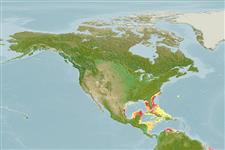Anoplodactylus dauphinus Child, 1992
| Native range | All suitable habitat | Point map | Year 2050 |

|
| This map was computer-generated and has not yet been reviewed. |
| Anoplodactylus dauphinus AquaMaps Data sources: GBIF OBIS |
Upload your photos
Google image |
No photo available for this species.No drawings available for Phoxichilidiidae.
Google image |
No photo available for this species.
Classification / Names Common names | Synonyms | CoL | ITIS | WoRMS
Pycnogonida | Pantopoda | Phoxichilidiidae
Environment: milieu / climate zone / depth range / distribution range Ecology
Benthic; depth range 22 - 78 m (Ref. 2115). Tropical
Distribution Countries | FAO areas | Ecosystems | Occurrences | Introductions
Western Central Atlantic: USA.
Length at first maturity / Size / Weight / Age
Maturity: Lm ? range ? - ? cm
Short description Morphology
Neck relatively long, slender. Ocular tubercle, including slender apical tubercle, as long as abdomen. Chelae each with 3 tiny teeth on both fingers. Legs with very long, major dorsodistal spines; femur with 2 low, tapering cement gland tubes; propodus with short lamina on distal half of sole; heel with 2 robust spines; auxiliaries minute (Ref. 2115, p. 46).
Depth to be replaced with better reference. Found on bay and nearshore. Epibiotic (Ref. 116112).
Life cycle and mating behavior Maturity | Reproduction | Spawning | Eggs | Fecundity | Larvae
Members of the class Pycnogonida are gonochoric and sexually dimorphic. During copulation, male usually suspends itself beneath the female. Fertilization occurs as the eggs leave the female's ovigers. Males brood the egg masses until they hatch. Life cycle: Eggs hatch into protonymphon larva then to adults.
Main reference
References | Coordinator | Collaborators
Child, C.A. 1992. (Ref. 2115)
IUCN Red List Status (Ref. 130435)
CITES status (Ref. 108899)
Not Evaluated
CMS (Ref. 116361)
Not Evaluated
Threat to humans
Human uses
| FishSource |
Tools
More information
Internet sources
BHL | BOLD Systems | CISTI | DiscoverLife | FAO(Publication : search) | Fishipedia | GenBank (genome, nucleotide) | GloBI | Gomexsi | Google Books | Google Scholar | Google | PubMed | Tree of Life | Wikipedia (Go, Search) | Zoological Record
Estimates based on models
Preferred temperature
(Ref. 115969): 21.1 - 27.5, mean 24.6 (based on 42 cells).
Price category
(Ref. 80766):
Unknown.


